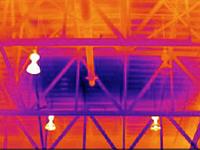Detection of Moisture and Water Intrusion Within Building Envelopes by Means of Infrared Thermographic Inspections

Infrared thermographic imagers have been used in the building industry since the 1980's, mainly for building envelope and heat loss analysis. Infrared imagers have developed significantly over the past 15 years and are now vital tools to determine performance characteristics of walls and roofs for both energy and structural integrity. With interior health issues coming to the forefront - such as mold issues, the infrared imager has again become a vital diagnostic tool. Although infrared imagers do not detect presence of mold, they can be used to detect presence of moisture by means of variances in heat transfer brought on by capacitance of water and phase change heat loss or gain. The infrared camera can be readily utilized to detect the extent of moisture intrusion in building structures in a much faster and convenient way than conventional moisture detection devices. When commissioning new building envelopes, or carrying out building condition inspections of existing building envelopes, it is imperative to differentiate the source of the moisture accumulation between interior or exterior sources since the recommendation for remedial action may vary considerably. Moisture detection methodologies for interior and exterior inspections vary and equipment specifications are different for both types of inspections. The physical mechanisms that produce moisture patterning in infrared wavelengths are different for both interior and exterior inspections. Ensuring optimal inspection conditions is paramount in order to obtain accurate inspection results. This paper discusses the various types of thermal patterns created by surface penetration of water versus those patterns created by air leakage from the building interior in cold winter conditions. Moisture detection methodologies for interior inspections are discussed and the importance of timing is stressed regarding detection of moisture within assemblies by non-destructive means.


Add comment
Log in to post comments